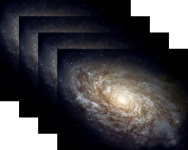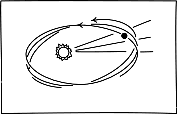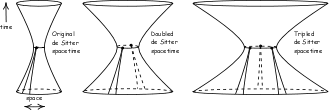|
John D. Norton
Case Studies
in
Induction and Confirmation
|
|
home >> research
>> induction and confirmation: case studies |
 |
In 1972, astronomers John N, Bahcall and Halton Arp debated at the
AAAS whether galactic redshifts resulted from a recession of the
galaxies. The material theory of induction is used to reveal and
assess their competing inductive inferences. |
"Inductive Inferences on Galactic Redshift,
Understood Materially." Ch. 9, pp. 227-246, in C. Soto (ed.), Current Debates in Philosophy of Science, Synthese Library 477. Springer: Cham, Switzerland, 2023. Download |
 |
The measure problem in eternal inflationary cosmology arises
because we try to force a probability distribution where it is not
warranted. The problem is solved by asking which inductive logic is
picked out by the background conditions. That logic is the same
highly non-additive inductive logic as applies to an infinite
lottery. |
"Eternal Inflation: When Probabilities Fail," Synthese 198
(Suppl 16) (2021), S3853-3875. Download. |
 |
This paper illustrates how the material theory of induction can be
used to assess evidential claims made historically in science. Two
cases are considered: Einstein's 1905 thermodynamic argument for
light quanta and his 1915 recovery of the anomalous perihelion
motion of Mercury. |
"History of Science and the Material Theory of
Induction: Einstein's Quanta, Mercury's Perihelion," European
Journal for Philosophy of Science. 1(2011),
pp. 3-27.Download. |
 |
What should we infer from the possibility of observationally
indistinguishable spacetimes? I urge they are not a manifestation of
the dubious thesis of the evidential underdetermination of theory,
but a form of indeterminism within a theory. Moreover inductively
discriminating among the spacetime requires inductive inferences
that are "opaque" in the sense the we cannot see through them to
their warrant. |
" Observationally Indistinguishable Spacetimes: A
Challenge for Any Inductivist." In G. Morgan, ed., Philosophy of
Science Matters: The Philosophy of Peter Achinstein. Oxford
University Press, 2011, pp. 164-176. Download |
|
The discovery of the "necessity" of quantum discontinuity by
Poincaré, Ehrenfest and others in the 1910s illustrates an
approach to inductive inference called "demonstrative induction"
or "eliminative induction." It is a powerful means of displaying
the import of evidence, fully able to defeat the common but
mistaken wisdom of the thesis of the necessary underdetermination
of theory by all possible evidence. The same approach is
illustrated in Einstein's discovery of general relativity, where
it functioned as a method of discovery.
|
"The Determination of Theory by Evidence: The Case
for Quantum Discontinuity 1900-1915," Synthese, 97 ,
1-31. Download
"Science and Certainty," Synthese, 99, pp.3-22.
"Eliminative Induction as a Method of Discovery: Einstein's
Discovery of General Relativity," in J. Leplin (ed.) The
Creation of Ideas in Physics: Studies for a Methodology of Theory
Construction. Dordrecht: Kluwer, 1995, pp.29-69. Download.
|
|
Thomson's 1897 discovery of the electron and Bohr's 1913
codification of its quantum properties in his theory of the hydrogen
atom illustrates different evidential strategies at work. |
"How We Know About Electrons," pp. 67- 97 in R. Nola
and H. Sankey, eds., After Popper, Kuhn and Feyerabend; Recent
Issues in Theories of Scientific Method. Dordrecht Kluwer. Download.
|
|
The rapid growth of our understanding of the nature of electrons
in the hundred years after their discovery illustrates a version of
structural reealism. |
With Jonathan Bain. "What Should Philosophers of
Science Learn from the History of the Electron." pp. 451-65 in J. Z.
Buchwald and A. Warwick, Histories of the Electron.
Cambridge MA: MIT Press, 2001. Download.
|
|
|



